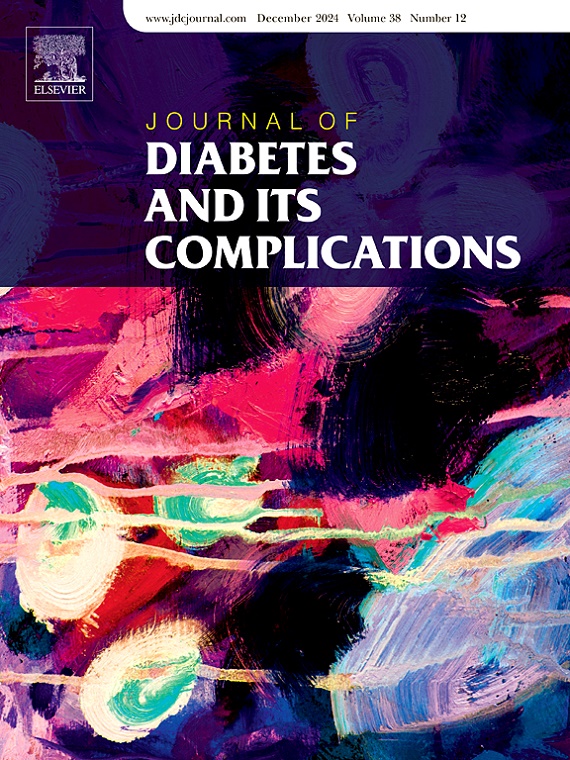sCD14作为糖尿病患者肾脏疾病进展的生物标志物
IF 3.1
3区 医学
Q3 ENDOCRINOLOGY & METABOLISM
引用次数: 0
摘要
目的探讨可溶性CD14 (sCD14)与糖尿病肾病(DKD)的关系及其对肾功能分期的预测作用。方法对80例2型糖尿病(T2D)患者进行横断面研究。对每位参与者进行DKD筛查,DKD的诊断标准为肾小球滤过率(eGFR)≤60 mL/min/1.73m2。ELISA法检测血清sCD14。采用Logistic回归模型和受试者工作特征(ROC)曲线评估sCD14与DKD的相关性及其对疾病分期的预测价值。结果DKD患者的scd14高于无肾脏疾病的T2D患者(p <;0.001)。根据肾功能分期,DKD患者sCD14逐渐升高(p <;0.001)。此外,血液透析中的DKD患者的sCD14高于未接受肾脏替代治疗的患者(p <;0.001)。在DKD患者中,sCD14与肌酐呈正相关(r = 0.282, p = 0.042),与eGFR呈负相关(r = - 0.365, p = 0.007)。sCD14水平可预测G3 (AUC = 0.822)、G4 (AUC = 0.876)和G5 (AUC = 0.924)期肾功能。在校正了年龄、性别和糖尿病病程的多因素logistic回归模型中,sCD14≥1720 ng/mL与DKD患者G3期(OR = 8.92, p = 0.023)、G4期(OR = 7.92, p = 0.011)和G5期(OR = 18.47, p = 0.017)相关。结论循环sCD14水平与DKD相关,可用于肾功能分期。因此,它是评估肾脏疾病进展风险的一个很好的候选。本文章由计算机程序翻译,如有差异,请以英文原文为准。
sCD14 as a biomarker for the progression of kidney disease among patients with diabetes
Aims
To investigate the association of soluble CD14 (sCD14) with diabetic kidney disease (DKD) and its prediction performance for kidney function staging.
Methods
A cross-sectional study of 80 type 2 diabetes (T2D) patients was conducted. Each participant was screened for DKD, and the diagnostic criterion for DKD was a glomerular filtration rate (eGFR) <60 mL/min/1.73m2. Serum sCD14 was measured by ELISA technique. Logistic regression models and receiver operating characteristics (ROC) curves were used to assess the association of sCD14 with DKD and its predictive value for disease staging.
Results
sCD14 was higher in DKD patients than in T2D patients without kidney disease (p < 0.001). sCD14 was progressively higher in DKD patients according to the kidney function stage (p < 0.001). Also, sCD14 was higher in DKD patients in hemodialysis than those who did not receive renal replacement therapy (p < 0.001). In DKD patients, sCD14 was positively correlated with creatinine (r = 0.282, p = 0.042) and negatively correlated with eGFR (r = −0.365, p = 0.007). The levels of sCD14 were predictive of G3 (AUC = 0.822), G4 (AUC = 0.876), and G5 (AUC = 0.924) stages of kidney function. In a multivariate logistic regression model adjusted for age, sex, and diabetes duration, sCD14 ≥ 1720 ng/mL were associated with G3 stage (OR = 8.92, p = 0.023), G4 (OR = 7.92, p = 0.011) and G5 stage (OR = 18.47, p = 0.017) in DKD patients.
Conclusion
Circulating levels of sCD14 are associated with DKD and perform well for kidney function staging. Thus, it is a good candidate for assessing the risk of kidney disease progression.
求助全文
通过发布文献求助,成功后即可免费获取论文全文。
去求助
来源期刊

Journal of diabetes and its complications
医学-内分泌学与代谢
CiteScore
5.90
自引率
3.30%
发文量
153
审稿时长
16 days
期刊介绍:
Journal of Diabetes and Its Complications (JDC) is a journal for health care practitioners and researchers, that publishes original research about the pathogenesis, diagnosis and management of diabetes mellitus and its complications. JDC also publishes articles on physiological and molecular aspects of glucose homeostasis.
The primary purpose of JDC is to act as a source of information usable by diabetes practitioners and researchers to increase their knowledge about mechanisms of diabetes and complications development, and promote better management of people with diabetes who are at risk for those complications.
Manuscripts submitted to JDC can report any aspect of basic, translational or clinical research as well as epidemiology. Topics can range broadly from early prediabetes to late-stage complicated diabetes. Topics relevant to basic/translational reports include pancreatic islet dysfunction and insulin resistance, altered adipose tissue function in diabetes, altered neuronal control of glucose homeostasis and mechanisms of drug action. Topics relevant to diabetic complications include diabetic retinopathy, neuropathy and nephropathy; peripheral vascular disease and coronary heart disease; gastrointestinal disorders, renal failure and impotence; and hypertension and hyperlipidemia.
 求助内容:
求助内容: 应助结果提醒方式:
应助结果提醒方式:


